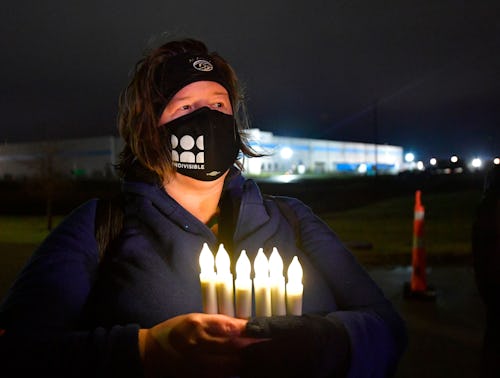Climate change is killing workers
A new report highlights how vulnerable some people are to climate disasters on the job.

Last year, a tornado ripped through Edwardsville, Illinois. Yet despite the warning of an incoming storm, employees at an Amazon factory were required to stay and work rather than and drivers were made to stay on the road. Six Amazon workers died when the tornado hit the facility.
While the tragedy was shocking due to the massive negligence of the employer, the fact is that there is little protection for workers who are exposed to extreme weather events. According to a report from Mother Jones, factory workers at a Kentucky warehouse that was hit by a tornado last year, killing eight people, are pursuing a class-action lawsuit against the company because there is little other recourse. While there are some rules on the books for worker safety, they are often barely enforced — the result of ongoing efforts by conservative politicians to cut funding to watchdog groups and regulators.
It’s not just a lack of funding that has put workers at risk, though. Even as evidence of climate change has become increasingly undeniable, government agencies have been slow to react.
In 2012, the Occupational Safety and Health Administration rejected a petition calling for a heat standard to be established, which would have set safety requirements for workers exposed to unusually high temperatures. Since then, at least 406 workers have died from extreme temperatures — including a 10-year high of 62 deaths in 2020, the most recent year for which data is available from the Bureau of Labor Statistics. Those deaths are twice as high as they were in the 1990s, according to an analysis performed by NPR.
The situation is growing more dire. The planet is warming, and the last seven years have been the hottest in recorded history. It’s making life, and especially work, much more dangerous. Our infrastructure isn’t built for this type of prolonged exposure to unseasonable weather, as evidenced by last year’s heat dome over the Pacific Northwest. As the temperature kept rising in the typically cool and rainy region, power cables melted, forcing public transit to shut down. Roads buckled.
While office workers are able to duck inside, many vital workers can’t escape extreme heat. Farm laborers, for instance, are particularly vulnerable — both because of the labor intensive work that they perform and because of the lack of protections afforded to them. They are 20 times more likely to die due to heat-related illness than the general population, per the Centers for Disease Control and Prevention. Construction workers, trash collectors, and other workers who can’t avoid the outdoors face similar threats and lack any sort of standard to protect them.
Under the Biden administration, OSHA has finally started to pursue a heat standard that would provide new protections for workers who are exposed to temperatures of 80 degrees or higher. But it’s a matter of too little, too late at this point. Temperatures are rising, and heat is just one of the dangerous conditions that are affecting workers.
A great way to help those workers is by establishing new standards to take into account the threats climate change poses to laborers. An even better way would be to seriously address climate change to keep the planet from warming to even more extreme levels.